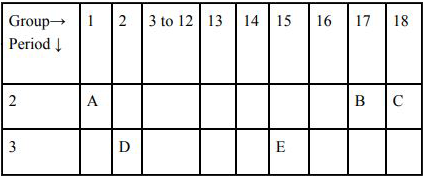Four elements P, Q, R and S have atomic numbers 12, 13, 14 and 15 respectively. Answer the following questions giving reasons:
(i) What is the valency of Q ?
(ii) Classify these elements as metals and non-metals.
(iii) Which of these elements will form the most basic oxide?
Step by step video & image solution for Four elements P, Q, R and S have atomic numbers 12, 13, 14 and 15 respectively. Answer the following questions giving reasons: (i) What is the valency of Q ? (ii) Classify these elements as metals and non-metals. (iii) Which of these elements will form the most basic oxide? by Chemistry experts to help you in doubts & scoring excellent marks in Class 10 exams.
Updated on:21/07/2023Topper's Solved these Questions
Similar Questions
Four elements P, Q, R and S have atomic numbers 12, 13, 14 and 15 respectively. Answer the following questions giving reasons :
(i) What is the valency of element Q ? (ii) Classify these elements as metals and non-metals.
(iii) Which of the elements will form the most basic oxide ?
View SolutionFour elements A, B, C and D have atomic numbers 12, 13, 14 and 15 respectively. Answer the following questions giving reasons:
(a) What is the number of valence electrons and valency of D? (b) Which of them will have largest atomic radii? (c ) Which of these elements will form the most basic oxide?
View Solution
Knowledge Check
Elements P, Q, R and S have atomic numbers 11, 15, 17 and 18 respectively. Which of them are reactive non-metals ?
AP and QBP and RCQ and RDR and SElements P, Q, R and S have atomic numbers 11, 15, 17 and 18 respectively, Which of them are reactive non-metals?
AP and QBP and RCQ and RDR and SElements P, Q, R and Shave atomic numbers 11, 15, 17 and 18 respectively. Which of them are reactive non-metals?
AP and QBP and RCQ and RDR and S
Elements P, Q R and S have atomic numbers 11, 15, 17 and 18 respectively. Which of them are reactive non-metals?
View SolutionRead the following elements and answer the below questions
Lead, Carbon, Nitrogen, Chlorine, Oxygen, Zinc .
Classify them as metals and non-metals.
View SolutionThe following table shows the position of five elements A, B, C, D and E in the modern periodic table.

Answer the following giving reasons:
(i) Which element is a metal with valency two?
(ii) Which element is least reactive?
(iii) Out of D and E which element has a smaller atomic radius?
View SolutionRohan was told that six elements A,B, C,D,E and F have atomic numbers of 2,12,20,18,4 and 10 respectively (where A,B,C,D,E and F are not the chemical symbols of these elements). Based on this information, Rohan was asked to answer the following questions:
(a) Which of these elements belong to the same groups of the periodic table? Why?
(b) Which of these element belong tothe same periods of the periodic table? Why?
(c) Which of these elements are (i) metals, and (ii) non-metals?
(d) Which of these elements are chemically (i) reactive and (ii) unreactive?
(e) What values are displayed by Rohan in answering the above questions?
View SolutionThere are four elements P,Q,R and S having atomic numbers of 4,18,10 and 16 respectively. The element which can exhibit covalency as well as electrovalency will be :
View Solution
